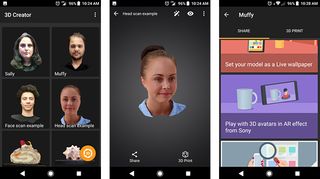Sony Xperia's 3D Creator is super fun but laborious to use
Futuristic but to an extent

Almost a decade ago, Sony Ericsson dazzled us with phones featuring the latest and greatest technologies such as the K790i. However, in the post iPhone world, Sony has slipped down the ranks, not only letting Apple and Samsung overrun it but even Chinese OEMs. Recently Sony launched their 2017 flagship, Xperia XZ1. It seems like another Xperia phone with the same old design, confusing name, and an under-delivered camera, but the XZ1 features an interesting tool- the 3D Creator. There will be many who are waiting to call it a gimmick, but the technology and its implementation is something we are yet to see in any other smartphone.
What is the 3D Creator?
The 3D Creator is a feature on the Xperia XZ1 that allows you to take a 3D scan of a person’s head or objects, and create a very accurate 3D image. A part of me says we may even see this feature being used in the coming James Bond movie, not just because they are known for Xperia product placement, but because it's damn cool. Imagine Bond at a crime scene, scanning the head of the corpse and sending it to the lab to find an ID, or scanning an object and sending it to HQ get more information on it.
It has been reported that the 3D Creator feature will be modified to work on a some of the other of Sony Xperia handsets through a software update. The feature is built using Sony's in-house "MotionEye" technology.
How to use it?
Even though the 3D scanning feature is a very sophisticated and complex piece of technology, using it isn't that confusing because of the interactive tutorial and video Sony has provided makes the whole process simpler. To scan something, you have to walk around the subject, connecting dots that appear on the screen, as the camera creates a 3D scan of the subject. Next step is the free-form sculpting process, which is a faster process as you just move the phone around in free form as the camera fills in the additional details like texture and tone to the scan.
However, before you try the process, you have to make sure to have soft and uniform lighting without any glares. Importantly you need a good amounts space in order to scan the subject by walking around it with the phone. Additionally, you have to maintain a distance from the subject as getting closer will hamper the process.
What can you do with the 3D scans?
The fun part comes when you can use the captured faces and heads to create custom avatars in the augmented reality app by superimposing it on a wide range of characters. You can make these avatars dance, jump or do pushups in the AR world. You can even send these to your friends through Facebook, Twitter, or WhatsApp. Interestingly you can even take a 3D print of the scans by either using a 3D printer or an online service.On the other hand, it should be pointed out the technology available in right now are very limited to take full advantage of a feature like this. However, with AR becoming more and more popular, 3D Creator could be something that will multiple applications of significant use.
However, everything isn't perfect when it comes to the 3D Creator. It took us 5 painstaking minutes to create our first 3D head. Even then it didn't come as perfect as the demos Sony would have you believe. Most times it is very confusing and requires a steady hand and extreme patience from both the person capturing and the person being scanned. Yes, the 3D creator is extremely fun to play, but the tedious process of capturing alone makes the prospect of using it less exciting.
Get daily insight, inspiration and deals in your inbox
Sign up for breaking news, reviews, opinion, top tech deals, and more.
Jibu Elias is the lead AI researcher at NASSCOM, lending his wide knowledge and keen insight into artificial intelligence in currently working towards building a unified AI eco-system backed by the Govt. of India. Coming from years of experience in covering emerging technologies, Jibu has a knack for putting seemingly unrelated things in the context of AI with a focus on ethical and legal implications of AI.
Most Popular

